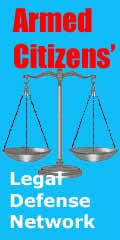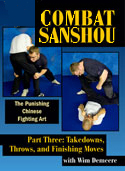|
In This Hub:
Alpha/Beta Behavior Angles Conflict in Training Control Presence Controlling Attack Range Controlling Where He Attacks Criminals Counting Coup De-Escalation Defensive Tactics DT: A Critical Review Distance Effective Movement Force Gun Retention Muscle Mushy Movement Pain as Motivation Patching Power Secondary Victory SD/DT/MA Training Shadow Dance Threat Display Unnecessary Movement Why Takedowns Go Wrong Yellow Tinted Back-Up LEO/Corrections Hub Martial Arts Hub NNSD Home Page Psychological Survival Hub Self Defense Hub Streetfighting Hub NNSD Home Page
Marc MacYoung? |
Excessive use of force
comes from FOREWORD FOR MARC MACYOUNG'S TAKE-DOWN BOOK By Massad Ayoob
When I first saw a book on streetfighting whose author’s name was "Marc ‘Animal’ MacYoung," my first reaction was "Oh, crap. Another phony wannabe who’s re-treading the World War II ‘give ‘em the knee’ stuff." Then I read the book. "Damn," I said. "He’s either been there or really done his homework with people who have." This has been the collective experience of people who know what they’re doing when they read Marc’s work. I’ve absorbed everything he’s written since. It rings with authority, particularly the elements of mind-set and what goes on in your head before, during, and after a fight. I appreciate his emphasis on avoidance, which is always a mark of the professional. This is MacYoung’s first work geared exclusively to the law enforcement community. While a record check will show him pretty much unblemished, he admits today that he’s one of those guys who straddled the edge of the law for part of his life, with one foot on a banana peel. He was smart enough to get through that phase without getting branded with a scarlet letter, and he cleaned up his act. I’ve known more than a few people like that. They’re the kind of folks you’re taught in the police academy to steer clear from, and the kind of person who would be on the "B list" of those your parole officer doesn’t want you associating with. I never entirely bought into that. If you’re going to manage human conflict, and teach others to manage it, one of the first things your realize is that if you do not understand your enemy, you’ll probably be defeated by him. I’ve learned things from the bad guys over the years. I was a young officer who was pretty good with the PR-24 baton when an outlaw biker told me "I could take that away from you if I wanted." When I suggested he try, he backed down, and it was over … for then. I talked to him later, and he apologized, saying, "I didn’t mean to make it a dick-measuring contest. I just made a statement of fact." We arranged for he and I to meet on neutral ground. Another cop had his hand on his .357 covering me, and we "worked out" by mutual consent. And, surprise, he did get the baton away from me. He had been Ranger-trained in a former life, and a certain rifle disarm technique worked with the baton. He and I sparred for a while longer … I found a technique that countered his disarm … and I shared it with brother PR-24 instructors. The result was enhanced officer safety. Sometimes, you learn from the other side. Marc MacYoung came to us from there, of his own volition. A violent past as a streetfighter and bouncer behind him, he became concerned that cops he’d made friends with in the martial arts world weren’t being given state of the art training. In the gym, the techniques they’d been taught to use to restrain men like Marc failed against him miserably. A mark of the real world fighter is that he understands his responsibilities in the aftermath, including the exposure of himself and those he works for to liability in the courts. Marc MacYoung learned as a bouncer how that worked, and he’s a bright guy who understands that it plays even heavier for law enforcement. For the book you’re about to read, he set about finding out what did work for takedown and restraint of violent individuals when, for lots of reasons, you didn’t want to kill or maim them. What he discovered, works. Do we like something because it works, or because it is similar to what we’re already doing and we get warm fuzzy feelings because this new thing validates what we’ve been doing? Both, probably, and I have no centrifuge into which I can throw MacYoung’s techniques and get a readout, "You like it X percent because it works, and X percent because it’s what you’re doing already." And frankly, it doesn’t matter. What matters is, it works. What Marc calls the Wedge, I call the Penetrating V and Tony Blauer calls the Spear and Chinese martial artists call something I can’t remember how to pronounce. But Marc has different followups. They all work. The point is, Marc’s techniques are valid, and you have them here in a book in your hands. A lot of MacYoung’s techniques in this book come from the Silat forms. Is it Pentjak Silat or Pentegar Silat? Marc once moaned to me, "Mas, every island in the chain seems to have its own form of Silat. Call it what you want!" Hell, most of us in the business just call it Silat. The best police instructors in Defensive Tactics – our term for unarmed combat and restraint – have been picking up on Silat the last few years and integrating it into our training. But you have to remember that in police work, it takes a lot time for new concepts to grow roots. Look how long it took before the American police establishment traded in revolvers designed in the 1890s and issued semiautomatic pistols. The Silat -based subtleties have not yet been taught to a good 90% of American law enforcement, yet they’re cutting edge for what cops need. I know MacYoung. I’ve worked out with him. He’s real, and his techniques are real. Don’t fall into the old parochial trap of thinking, "He hasn’t done my job, so he doesn’t know what I need." That’s a false standard of judgment. He’s not teaching you how to be a cop, and he wouldn’t presume to. He’s teaching you how to do something he has learned – in the dojo, in the gym, and most important, on the street – how to do, and it’s something that fits in with what you need to know. Read this book with an open mind. Try his techniques in a safe environment – supervision, mats, warmups, the whole nine yards. I think you’ll be impressed. I know I was. Don’t just read this book. Absorb this book, and what it teaches. Whether you’re a police officer or a citizen who might have to do a police officer’s job long enough to hold the line against criminal danger until a real cop gets there to take over, what’s in here can save your life and other lives, your career and other careers, your future and the futures of other good people.
A sworn police officer for some 25 years, Massad Ayoob became a master instructor in Defensive Tactics under Grandmaster Jim Morell, International Instructor in the PR-24 baton under Joe Truncale and Lon Anderson, and National Instructor in handgun retention/disarming under Jim Lindell of the National Law Enforcement Training Center. He has held two national champion titles in combat handgun shooting, was the 1998 Outstanding American Handgunner, and has been called the nation’s leading authority on the use of deadly force. Since 1987, Ayoob has been head of firearms/deadly force training for the American Society of Law Enforcement Trainers, and he is the director of Lethal Force Institute, PO Box 122, Concord, NH 03301. His articles on unarmed combat have appeared in Black Belt, Karate Illustrated, Official Karate, and numerous other publications.
|

|
||||||
|
||||||||












